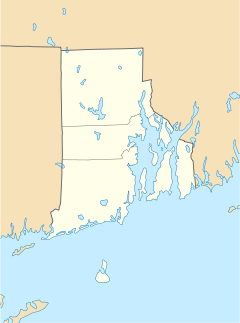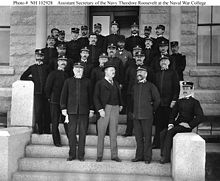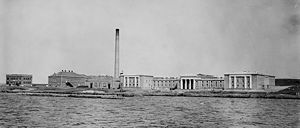- Naval War College
-
US Naval War College
 The Naval War College. The original Newport Asylum building can be seen on the far right, now housing the Naval War College Museum. The larger building on the left is Luce Hall.
The Naval War College. The original Newport Asylum building can be seen on the far right, now housing the Naval War College Museum. The larger building on the left is Luce Hall.Location: Newport, Rhode Island Coordinates: 41°30′24″N 71°19′44″W / 41.50667°N 71.32889°WCoordinates: 41°30′24″N 71°19′44″W / 41.50667°N 71.32889°W Built: 1884 Architect: Mason,George C., & Sons Architectural style: Other Governing body: DEPARTMENT OF THE NAVY NRHP Reference#: 66000876[1] Significant dates Added to NRHP: October 15, 1966 Designated NHLD: January 29, 1964 The Naval War College (NWC or NAVWARCOL) is an education and research institution of the United States Navy that specializes in developing ideas for naval warfare and passing them along to officers of the Navy.[2] The college is located on the grounds of Naval Station Newport in Newport, Rhode Island. In addition to its degree programs, the College hosts various symposia and conferences.
Contents
History
The College was established on October 6, 1884, and its first president, Commodore Stephen B. Luce, was given the old building of the Newport Asylum for the Poor to house it on Coaster's Harbor Island in Narragansett Bay. [3] Among the first four faculty members were Tasker H. Bliss, a future Army Chief of Staff, James R. Soley, the first civilian faculty member and a future Assistant Secretary of the Navy, and, most famously, Captain (later, Rear Admiral) Alfred Thayer Mahan, who soon became renowned for the scope of his strategic thinking and influence on naval leaders worldwide. Despite Mahan's prestige, the College was long met with skepticism by Navy officers accustomed to conducting all education aboard ship.
The College engaged in wargaming various scenarios from 1887 on, and in time became a laboratory for the development of war plans. Nearly all of the U.S. naval operations of the twentieth century were originally designed and gamed at the NWC.
One of the most famous achievements of the NWC was the Global War Game, a large-scale wargaming effort to model possible United States-Soviet Union confrontation during the Cold War.
The current president is Rear Admiral John N. Christenson, the fourth of six sons of a Navy Skyraider pilot and a Navy nurse, he graduated from the U.S. Naval Academy in 1981. He graduated with distinction and first in his class from the Naval War College, earning his master's degree in National Security and Strategic Studies. He was also a Navy Federal Executive Fellow at the Fletcher School of Law and Diplomacy.
As of 2008, in response to military to demand for education on irregular warfare the NWC started the Center for Irregular Warfare and Armed Groups.
Curricula
Its principal courses of study are "Strategy and Policy", "National Security and Decision Making", and "Joint Military Operations". [4] Students from all branches of the military, as well as foreign militaries, work towards a Master of Arts.
The Naval War College has two international courses, Naval Command College (NCC) and Naval Staff College (NSC), specifically prepared for the naval officers of other nations. Graduates of these programs include numerous chiefs of the maritime forces all over the world.
Despite the extensive international presence, the Naval War College, unlike other U.S. military staff colleges, has never granted a master's degree to an officer of another nation.[citation needed] The Naval War College declines to grant degrees to its international graduates because some officers from other navies have no undergraduate credential, generally an essential requirement for conferring a master's degree in the United States. However, it is possible for both American and international students at the Naval War College to obtain a Master of Arts degree through the graduate program in international relations at nearby Salve Regina University.
Publications
The Naval War College Press has published the scholarly quarterly journal the Naval War College Review since 1948..[5] It also publishes the 'Newport Papers", as well as an historical monograph series, Newport Papers, and occasional books.
Buildings and structures
Over the years, the Naval War College has expanded greatly. The original building, the former Newport Asylum for the Poor, now serves as home to the Naval War College Museum. In 1892, the structure now known as Luce Hall opened as the college's new home, at a cost of $100,000. At the time, the building housed lecture rooms and a library. Wings at either end provided two sets of quarters, occupied by the president of the College and members of the faculty. When the Naval War College was enlarged in 1932, this original building was renamed Luce Hall in honor of the institution's founder and first Superintendent (later President), Stephen B. Luce. The building was entered onto the National Register of Historic Places on September 22, 1972.

Mahan Hall, named for Rear Admiral Alfred Thayer Mahan (NWC President from 1886–1889 and 1892–1893), was completed and opened in 1904, and encompasses the historic Mahan Rotunda and Reading Room, as well as student study areas. The Mahan Rotunda also serves as an impromptu museum of gifts and artifacts donated by graduating international students over the years.
Pringle Hall (named for Vice Admiral Joel R. P. Pringle, NWC President from 1927–1930) was opened in 1934, and was the principal site for war gaming from the time of its completion in 1934 until the Naval Electronic Warfare Simulator was built in Sims Hall in 1957. The exterior facing of the building is pink Milford granite, similar in appearance to the ashlar granite of Luce Hall, to which it is connected by two enclosed bridges. Pringle Hall contains a 432-seat auditorium, the Quinn Lecture Room, the Naval Staff College, the Graphic Arts Studio, the Photography Branch, and the Naval War College Press.
In 1947, the NWC acquired an existing barracks building and converted it to a secondary war gaming facility, naming it Sims Hall after former War College President Admiral William Sowden Sims (NWC President from Feb. to Apr. 1917 and again from 1919–1922). In 1957 Sims Hall became the primary center for the Naval War College's wargaming department, serving as such until 1999.
The 1970s saw the War College's most active expansion, with the opening of three separate buildings. In 1972, Spruance Hall, named for former NWC President Admiral Raymond A. Spruance (March 1946 - July 1948), was completed, housing faculty offices and an 1,100 seat auditorium.
In 1974, Conolly Hall was opened and named in honor of Admiral Richard L. Conolly, Naval War College President 1950–1953. It houses the NWC Quarterdeck, Administrative and faculty offices, numerous class and conference rooms, and two underground parking garages.
1976 saw the opening of Hewitt Hall, one of two Naval War College buildings not named for a War College president, this time taking its name from Admiral Henry Kent Hewitt, an advisor to the NWC during his tenure as Commander, U.S. Naval Forces Europe, following World War II. Hewitt Hall is home to the Henry E. Eccles Library, the Trident Café, the bookstore and barbershop, and student study areas and lounge.
In 1999, the state-of-the-art McCarty Little Hall opened, replacing Sims Hall as the War College's primary wargaming facility. The other building named for a non-president is named after Captain William McCarty Little, an influential leader and key figure in refining the techniques of war gaming. This high-tech facility is used primarily by the Center for Naval Warfare Studies to conduct war games and major conferences, and for research and analysis. The building features the technology necessary to support a variety of multi-media needs essential during multiple and simultaneous war games.
Notable U.S. graduates
U.S. NAVY
- Fleet Admiral Ernest J. King, Chief of Naval Operations, 1942–45
- Fleet Admiral Chester W. Nimitz, Chief of Naval Operations, 1945–47
- Fleet Admiral William F. Halsey, Jr., World War II decorated officer
- Admiral William Fallon, Commander, U.S. Central Command, 2007–2008
- Admiral George McMillin, 38th and final Naval Governor of Guam, one of the first WWII POWs at First Battle of Guam 1940-1941
- Admiral Kent Hewitt, World War II decorated officer
- Admiral Thomas H. Moorer, Chairman, Joint Chiefs of Staff, 1970–74
- Admiral Raymond Spruance, World War II decorated officer
- Admiral James G. Stavridis, Commander in Chief, Supreme Allied Commander Europe, 2009-
- Admiral Elmo Zumwalt, 19th Chief of Naval Operations, 1970–74
- Admiral Jeremy Michael Boorda, 25th Chief of Naval Operations, 1994–96
- Rear-Admiral Alan Shepard, USN First American in Space 1961; Fifth Man on the Moon 1971
U.S COAST GUARD
- Admiral Robert E. Kramek, USCG, Commandant of the U.S. Coast Guard, 1990–1994
- Admiral Robert J. Papp, Jr., USCG, Commandant of the U.S. Coast Guard, 2010-
U.S. MARINE CORPS
- General Walter Boomer, USMC, Assistant Commandant, U.S. Marine Corps, 1992–1994
- General Michael Hagee, USMC, Commandant, U.S. Marine Corps
- General James E. Cartwright, USMC, Vice Chairman, Joint Chiefs of Staff, 2007-
U.S. ARMY
- General John Shalikashvili, USA, Chairman, Joint Chiefs of Staff, 1993–97
- General Raymond T. Odierno, USA, Commander, U.S. Forces Iraq , 2008-
- General Stanley McChrystal, USA, Commander, International Security Assistance Force/United States Forces Afghanistan, 2009-2010
U.S. AIR FORCE
- General Charles A. Gabriel, USAF, Chief of Staff, U.S. Air Force, 1982–86
- General John W. Corley, USAF, Commander, Air Combat Command, 2007-
- General John A. Gordon, USAF, Deputy Director, Central Intelligence Agency, 1997–2000
- General Richard E. Hawley, USAF, Commander, Air Combat Command, 1996–1999
- General Jerome F. O'Malley, USAF, Commander, US Air Forces Europe, 1990–1994
- General Robert C. Oaks, USAF, Commander, Tactical Air Command, 1984–1985
- General Bruce Carlson, USAF, Commander, Air Force Materiel Command, 2005–2008
- General Robert C. Kehler, USAF, Commander, Air Force Space Command, 2007-
U.S. FOREIGN SERVICE
- Ambassador Christopher R. Hill, U.S. Ambassador to Iraq and former Assistant Secretary of State for East Asian and Pacific Affairs
U.S. CIVIL SERVICE
- Frank Jimenez, former General Counsel, U.S. Department of the Navy, 2006–2009
- Hugo Teufel III, 2nd Chief Privacy Officer, Department of Homeland Security in the Government of the United States, 2006–2009
Notable international graduates
- Admiral Panagiotis Chinofotis, Chief of the Hellenic National Defense General Staff, 2005 - .
- Admiral Arun Prakash, Chief of the Naval Staff, Indian Navy, and Chairman, Chiefs of Staff Committee, India, 2004–2006.
- Admiral Radhakrishna Hariram Tahiliani, Chief of the Naval Staff, Indian Navy, 1984–1987.[6]
- Admiral Nirmal Kumar Verma, Chief of the Naval Staff, Indian Navy, 2009–present.[7]
- Vice Admiral Tomás Gomez Arroyo Spanish Navy, 1972-1973.
- Vice Admiral Mateo M Mayuga AFP Flag Officer In Command, Philippine Navy 09 Dec 10 - 09 Dec 07
- Vice Admiral Thisara Samarasinghe, Commander, Sri Lankan Navy, 2009–present.[7]
- Vice Admiral Russ Shalders, Chief of Navy, Australia, 2005-2008.
- Vice Admiral Ko Tun-hwa former Vice Minister of Defense, Republic of China and is currently the National Policy Advisor to the President of the Republic of China (Taiwan).
- Vice Admiral Zahir Uddin Ahmed, Chief of Naval Staff, Bangladesh Navy, 2009–present
- General Håkan Syrén, Supreme Commander of the Swedish Armed Forces, 2003–2009; Chairman, European Union Military Committee, 2009 - .
See also
- National War College
- Marine Corps War College
- Army War College
- Air War College
References
- ^ "National Register Information System". National Register of Historic Places. National Park Service. 2007-01-23. http://nrhp.focus.nps.gov/natreg/docs/All_Data.html.
- ^ "U.S. Naval War College: About". U.S. Naval War College. http://www.usnwc.edu/About.aspx. Retrieved 2011-05-23.
- ^ "U.S. Naval War College: History". U.S. Naval War College. http://www.usnwc.edu/About/History.aspx. Retrieved 2011-05-23.
- ^ "U.S. Naval War College: Academics". U.S. Naval War College. http://www.usnwc.edu/Academics.aspx. Retrieved 2011-05-23.
- ^ "Overview of the Naval War College PRess". U.S. Naval War College. http://www.usnwc.edu/Publications/Naval-War-College-Press/Overview.aspx. Retrieved 2011-05-23.
- ^ "Admiral Radhakrishna Hariram Tahiliani, PVSM, AVSM". Information Resource Facilitation Centre, Indian Navy. http://irfc-nausena.nic.in/modules.php?name=Content&pa=showpage&pid=88. Retrieved 2011-10-18.
- ^ a b http://defence.lk/new.asp?fname=20091012_04
External links
Federal service academies UndergraduatePost-graduateSenior military colleges PublicPrivateJunior military colleges PublicPrivateUnited States staff colleges National Defense University · Joint Forces Staff College · Defense Language Institute · U.S. Army War College · Command and General Staff College · School of Advanced Military Studies · Marine Corps University · Marine Corps War College · Naval War College · Naval Postgraduate School · Air University · Air Command and Staff College · Air War College · Air Force Institute of Technology · Community College of the Air Force · U.S. Army Warrant Officer Career CollegeColleges and universities in Rhode Island Public institutions CCRI · Naval War College · Rhode Island College · University of Rhode Island
Private institutions Brown · Bryant · Johnson & Wales · New England Tech · Providence · RISD · Roger Williams · Salve Regina
Professional schools U.S. National Register of Historic Places Topics Lists by states Alabama • Alaska • Arizona • Arkansas • California • Colorado • Connecticut • Delaware • Florida • Georgia • Hawaii • Idaho • Illinois • Indiana • Iowa • Kansas • Kentucky • Louisiana • Maine • Maryland • Massachusetts • Michigan • Minnesota • Mississippi • Missouri • Montana • Nebraska • Nevada • New Hampshire • New Jersey • New Mexico • New York • North Carolina • North Dakota • Ohio • Oklahoma • Oregon • Pennsylvania • Rhode Island • South Carolina • South Dakota • Tennessee • Texas • Utah • Vermont • Virginia • Washington • West Virginia • Wisconsin • WyomingLists by territories Lists by associated states Other Categories:- Historic districts in Rhode Island
- Naval War College
- United States Navy organization
- Staff colleges
- Military education and training in the United States
- New England Association of Schools and Colleges
- Public universities and colleges in Rhode Island
- National Historic Landmarks in Rhode Island
- Military facilities on the National Register of Historic Places in Rhode Island
- Education in Newport County, Rhode Island
- Historic districts in Newport County, Rhode Island
- Buildings and structures in Newport, Rhode Island
- Educational institutions established in 1884
Wikimedia Foundation. 2010.





